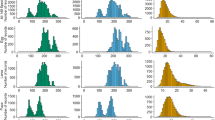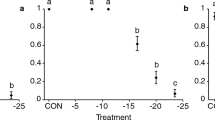Abstract
The sap-sucking lace bug Gargaphia decoris Drake (Hemiptera: Tingidae) is a biological control agent released in New Zealand to control the invasive small tree or shrub Solanum mauritianum Scopoli (Solanaceae). The aim of this study was to investigate the effect of temperature, photoperiod and humidity on selected G. decoris life history traits. The selected traits were measured at six different temperatures (10, 15, 20, 25, 27.5 and 30 °C), three photoperiods (L:D 6:16, 14:10 and 16:8) and two relative humidity (RH) levels (50 and 70 ± 10%). Eggs and nymphs did not survive in the 10 °C and 30 °C treatments. The net reproductive rate (R0) resulted in population growth at all temperatures, but was highest at 25 °C. Egg hatch rate was highest at L:D 8:16, and nymphal and adult survival was better at L:D 16:8. Egg hatch was higher at 50 ± 10% RH and adult survival and population growth were higher at 70 ± 10% RH. These results will help to predict the persistence of established G. decoris populations and the potential for establishment at new release sites.



Similar content being viewed by others
References
Bale JS, Masters GJ, Hodkinson ID, Awmack C, Bezemer TM, Brown VK, Butterfield J, Buse A, Coulson JC, Farrar J, Good JEG, Harrington R, Hartley S, Jones TH, Lindroth RL, Press MC, Symrnioudis I, Watt AD, Whittaker JB (2002) Herbivory in global climate change research: direct effects of rising temperature on insect herbivores. Glob Chang Biol 8:1–16
Barker AL, Byrne MJ (2005) Biotypes and biocontrol: physiological factors affecting the establishment of a South American lace bug Gargaphia decoris, a biological control agent of bugweed, Solanum mauritianum. In: Villet MH (ed). Proceedings of the 15th entomological congress. Entomological Society of Southern Africa. Pretoria, South Africa, p 8
Bean DW, Dudle TL, Keller JC (2007) Seasonal timing of diapause induction limits the effective range of Diorhabda elongata deserticola (Coleoptera: Chrysomelidae) as a biological control agent for Tamarisk (Tamarix spp.). Environ Entomol 36:15–25
Beck SD (1980) Insect photoperiodism, 2nd edn. Academic Press, New York, p 398
Briere JF, Pacros P, Le Roux AY, Pierre JS (1999) A novel rate model of temperature-dependent development for arthropods. Environ Entomol 28:22–29
Byrne MJ, Currin S, Hill MP (2002) The influence of climate on the establishment and success of the biological control agent Gratiana spadicea, released on Solanum sisymbriifolium in South Africa. Biol Control 24:128–134
Caswell H (1989) Matrix population models. Sinauer Assoc, Massachusetts
Chappell PR (2013a) The climate and weather of Bay of Plenty, NIWA Science and Technology Series, vol 62, p 40
Chappel PR (2013b) The climate and weather of Auckland, NIWA Science and Technology Series, vol 60, p 40
Chappel PR (2013c) The climate and weather of Northland. NIWA Science and Technology Series, vol 59, p 40
Cowie BW, Byrne MJ, Witkowski ETF, Venter N (2016a) Exacerbation of photosynthetic damage through increased heat-light stress resulting from Gargaphia decoris sap-feeding. Biol Control 94:82–89
Cowie BW, Venturi G, Witkowski ETF, Byrne MJ (2016b) Does climate constrain the spread of Anthonomus santacruzi, a biological control agent of Solanum mauritianum, in South Africa? Biol Control 101:1–7
Cowie BW, Venter N, Witkowski ETF, Byrne MJ, Olckers, T (2018) A review of Solanum mauritianum biocontrol: prospects, promise and problems: a way forward for South Africa and globally. BioControl 63:475–491
Culliney T (2005) Benefits of classical biological control for managing invasive plants. Crit Rev Plant Sci 24:131–150
Drake CJ, Ruhoff FA (1965) Lace bug genera of the world (Hemiptera:Tingidae). Proc USNM 112:1–105
EPA, Environmental Protection Authority Decision (2009) NORO8003 decision. https://epa.govt.nz/search/SearchForm?Search=Gargaphia+decoris
Fowler S (2014) Lace bug does best in shade. Weed biocontrol newsletter, Issue 69, Landcare Research, Manaaki Whenua, Lincoln
Hayes L (1996) The biological control of weeds book: a New Zealand guide. ISBN 0-478-09306-3. Published by Manaaki Whenua, Landcare Research, p 150. http://www.landcareresearch.co.nz/publications/books/biocontrol-of-weeds-book
Hope KJ, Olckers T (2011) Gargaphia decoris (Hemiptera:Tingidae) from two South American provenances are equally safe for release against the invasive tree, Solanum mauritianum (Solanaceae). Afr Entomol 19:106–112
Klein H (2011) A catalogue of the insects, mites and pathogens that have been used or rejected, or are under consideration, for the biological control of invasive alien plants in South Africa. Afr Entomol 19:515–549
LINZ, Land Information New Zealand (2018) Sunrise and sunset tables July 2018–June 2019. Data retrieved from United States Naval Observatory (USNO). https://www.linz.govt.nz/sea/nautical-information/astronomical-information
Logan JA, Wollkind DJ, Hoyt SC, Tanigoshi LK (1976) An analytical model for description of temperature dependent rate phenomena in arthropods. Environ Entomol 5:1133–1140
Olckers T (2000) Biology, host specificity and risk assessment of Gargaphia decoris, the first agent to be released in South Africa for the biological control of the invasive tree Solanum mauritianum. BioControl 45:373–388
Olckers T (2011) Biological control of Solanum mauritianum Scop. (Solanaceae) in South Africa: will perseverance pay off? Afr Entomol 19:416–426
Olckers T, Borea CK (2009) Assessing the risks of releasing a sap-sucking lacebug, Gargaphia decoris, against the invasive Solanum mauritianum in New Zealand. BioControl 54:143–154
Patrick K, Olckers T (2011) Influence of shade on the persistence of Gargaphia decoris (Tingidae), a biological control agent of Solanum mauritianum (Solanaceae) in South Africa. Afr Entomol 22:891–895
R Development Core Team (2014) R: a language and environment for statistical computing. R Foundation for Statistical Computing, Vienna
SAS Institute Inc (2009) SAS/STAT® 9.2. User’s guide, 2nd edn. SAS Institute Inc, Cary. http://www.r-project.org/
Saunders DS (1987) Maternal influence on the incidence and duration of larval diapause in Calliphora vicina. Physiol Entomol 12:331–338
Saunders DS (2014) Insect photoperiodism: effect of temperature on the induction of insect diapause and diverse roles for the circadian system in the photoperiodic response. J Entomol Sci 17:25–40
Simelane DO (2007) Influence of temperature, photoperiod and humidity on oviposition and egg hatch of the root-feeding flea bettle Longitarsus bethae (Chrysomelidae:Alticinae), a natural enemy of the weed Lantana camara (Verbenacea). Bull Entomol Res 97:111–116
Tallamy DW, Denno RF (1982) Life history trade-offs in Gargaphia solani (Hemiptera:Tingidae): the cost of reproduction. Ecology 63:616–620
Taylor PS, Shields EJ, Tauber MJ, Tauber CA (1995) Induction of reproductive diapause in Empoasca fabae (Homoptera:Cicadellidae) and its implications regarding southward migration. Environ Entomol 24:1086–1095
Wilson EO (2000) Sociobiology: the new synthesis. Harvard University Press, Massachusetts, p 697
Witt ABR (2007) Bugweed under attack. Plant Prot News 72:11
Acknowledgements
We thank Landcare Research based in Auckland, New Zealand for providing insects and plant stock for purposes of this study and the staff of the Institute of Agriculture and Environment and Plant Growth Unit, Massey University, for providing technical assistance.
Author information
Authors and Affiliations
Corresponding author
Ethics declarations
Conflict of interest
The authors declare that they have no conflict of interest.
Research involving human participants and/or animals
No humans and/or animals were used in this study that required and informed consent or submission to animal welfare committee for evaluation.
Additional information
Handling Editor: S. Raghu
Rights and permissions
About this article
Cite this article
Falla, C., Najar-Rodriguez, A., Minor, M. et al. Effects of temperature, photoperiod and humidity on the life history of Gargaphia decoris. BioControl 64, 633–643 (2019). https://doi.org/10.1007/s10526-019-09969-7
Received:
Accepted:
Published:
Issue Date:
DOI: https://doi.org/10.1007/s10526-019-09969-7




